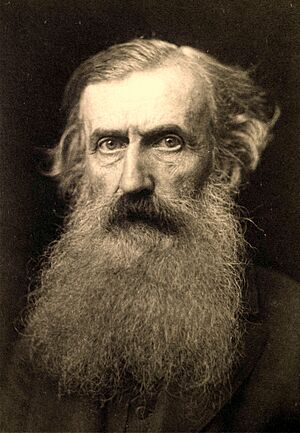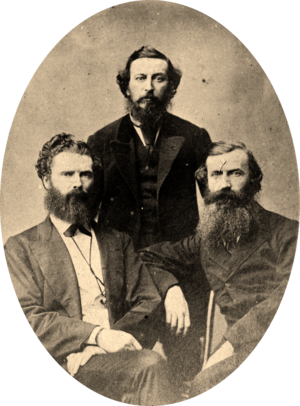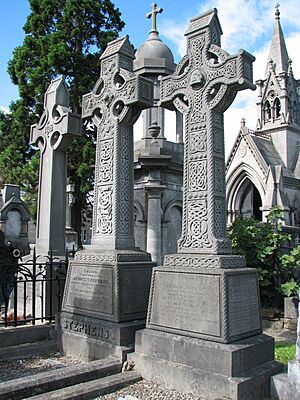John O'Leary (Fenian) facts for kids
Quick facts for kids
John O'Leary
|
|
|---|---|

O'Leary, 1900
|
|
| President of the Irish Republican Brotherhood | |
| In office 1891 – 16 March 1907 |
|
| Preceded by | John O'Connor Power |
| Succeeded by | Neal O'Boyle |
| Personal details | |
| Born | May 23, 1830 Tipperary, County Tipperary, Ireland |
| Died | March 16, 1907 (aged 76) |
| Occupation | Irish Republican |
John O'Leary (born 23 July 1830 – died 16 March 1907) was an important Irish leader. He wanted Ireland to be completely independent from Britain. He was a key member of a group called the Fenians. He studied law and medicine, but he did not finish his degrees. He was put in prison in England because of his involvement with the Irish Republican Brotherhood.
Contents
Who Was John O'Leary?
John O'Leary was born in Tipperary, County Tipperary, Ireland. He was Catholic, but he went to a local Protestant school called The Abbey School. Later, he attended the Catholic Carlow College. He agreed with the ideas of Thomas Davis, who was a writer and politician. In 1846, he met James Stephens, who would later become a very important figure in Irish history.
In 1847, John O'Leary began studying law at Trinity College in Dublin. There, he joined a group called the Grattan Club. Through this club, he met other significant people like Charles Gavan Duffy and Thomas Francis Meagher.
The 1848 Uprising
In 1848, there was a failed uprising in Tipperary. After this, O'Leary tried to free the leaders of the Young Ireland movement from prison in Clonmel. Because of this, he was put in prison himself for one week in September 1849. He also took part in another attempted uprising in Cashel later that month, but it also failed.
Joining the Irish Republican Brotherhood
O'Leary stopped studying law at Trinity College. This was because he did not want to promise loyalty to the British Crown, which was required to become a lawyer. He then went to study medicine at Queen's College in Cork in 1850. He later moved to Queen's College in Galway and continued his studies in Dublin, Paris, and London.
In 1855, he visited Paris. There, he met Kevin Izod O'Doherty and the famous American painter, James Abbott McNeill Whistler. John O'Leary later became the person who managed the money for the new Irish Republican Brotherhood (IRB). He also helped edit the IRB's newspaper, The Irish People.
Arrest and Exile
On 16 September 1865, John O'Leary was arrested. He was later tried for serious crimes against the government. He was sentenced to twenty years in prison. He spent five years in English prisons before he was released and sent away from Ireland in January 1871.
During his time away, he mostly lived in Paris. He also visited the United States. He continued to be active in the IRB and other related groups. He wrote many letters to newspapers and journals, sharing his ideas.
Returning to Ireland
In 1885, his 20-year prison sentence ended. This meant he could finally return to Ireland. He and his sister, Ellen O'Leary, who was a poet, became important people in Dublin. They were part of groups that focused on Irish culture and independence. Famous people like W. B. Yeats, Maud Gonne, and Katharine Tynan were part of their circle.
O'Leary also became a respected older leader in the movement for Irish independence. He was involved in the Young Ireland Society. He also led a group called the Irish Transvaal Committee, which supported the Boer side in the Boer War.
What John O'Leary Believed In
John O'Leary was a separatist. This means he strongly believed that Ireland should be completely independent from Britain. He thought that force might be needed to achieve this. However, he was against individual acts of violence. He believed that any big revolutionary action should be carefully planned.
He did not agree with the land protests led by Michael Davitt and Parnell. For most of his life, he was against Irish politicians working in the British Parliament. He especially disliked John O'Connor Power, who was a former Fenian who became a Member of Parliament. However, he did support Parnell for a short time during a political disagreement in 1890–91.
O'Leary believed that the Church should not be involved in politics. He also thought that Protestants in an independent Ireland should have their freedoms protected. Unlike some others of his time, he was not very interested in the Irish language. But he did support groups that worked to bring back Irish culture in the 1880s.
His Personal Life
John O'Leary never married. He was raised Catholic, but he did not practice the religion for most of his life. However, he became religious again near the end of his life, around Christmas 1906.
He inherited property from his family in Tipperary. This gave him enough money to live comfortably. He was also able to help other Irish independence supporters financially.
A Poet's Tribute: W.B. Yeats
The famous poet W.B. Yeats wrote about John O'Leary. In his poem "September 1913", Yeats sadly mentions O'Leary's death with these lines:
- "Romantic Ireland's dead and gone;
- It's with O'Leary in the grave."
Yeats also mentioned O'Leary in another poem called "Beautiful Lofty Things":
- "Beautiful lofty things: O'Leary's noble head;"
His Writings
- Young Ireland: The Old and the New (1885)
- Recollections of Fenians and Fenianism, 2 volumes, London, 1896




